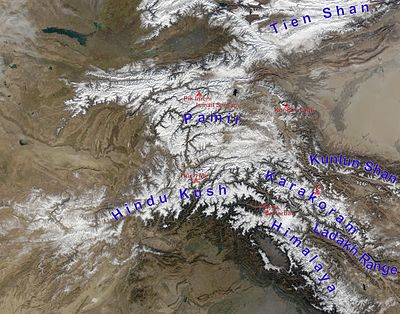Roof of the World

The Roof of the World or Top of the World is a metaphoric epithet or phrase used to describe the highest region in the world, also known as High Asia. The term usually refers to the mountainous interior of Asia, including the Pamirs, the Himalayas, the Tibetan Plateau, the Hindu Kush, the Tian Shan, and the Altai Mountains.
Attested usage
The British explorer John Wood, writing in 1838, described Bam-i-Duniah (Roof of the World) as a "native expression" (presumably Wakhi),[1] and it was generally used for the Pamirs in Victorian times: In 1876, another British traveler, Sir Thomas Edward Gordon, employed it as the title of a book[2] and wrote in Chapter IX:
- "We were now about to cross the famous 'Bam-i-Dunya', 'The Roof of the World' under which name the elevated region of the hitherto comparatively unknown Pamir tracts had long appeared in our maps.[...] Wood, in 1838, was the first European traveler of modern times to visit the Great Pamir,".[3]
Older encyclopedias also used "Roof of the World" to describe the Pamirs:
- Encyclopædia Britannica, 11th ed. (1911): "PAMIRS, a mountainous region of central Asia...the Bam-i-Dunya ('The Roof of the World')".[4]
- The Columbia Encyclopedia, 1942 edition: "the Pamirs (Persian = roof of the world)".[5]
- Der Große Hindukush, and therefore called the roof of the world."[8]
With the awakening of public interest in Tibet, the Pamirs, "since 1875 ... probably the best explored region in High Asia",


See also
References
- ISBN 0-7126-0196-1; p. 153
- ^ Sir Thomas Edward Gordon, The Roof of the World: being a narrative of a journey over the high plateau of Tibet to the Russian frontier and the Oxus sources on Pamir, Edinburgh: Edmonston and Douglas, 1876
- ^ Gordon, p. 121f.
- ^ a b Holdich, Thomas Hungerford (1911). . In Chisholm, Hugh (ed.). Encyclopædia Britannica. Vol. 20 (11th ed.). Cambridge University Press. p. 655.
- ^ The Columbia Encyclopedia; 1942 edition, p. 1335
- ISBN 2-95099-0029Guillaume Capus
- ^ Der Große Brockhaus in 20 vols, 15th ed., Leipzig 1928–35, vol. 4 (1929), p. 319
- ^ Der Große Brockhaus, vol. 14 (1933), p. 96
- OCLC 845721671.
- ^ "Tibet: Climate Action for the Roof of the World". Central Tibetan Administration. Retrieved 2017-04-17.
- ^ Encyclopédie et Dictionnaires Larousse.
- ^ The Pamirs, a region known to locals as Pomir – "the roof of the world".
